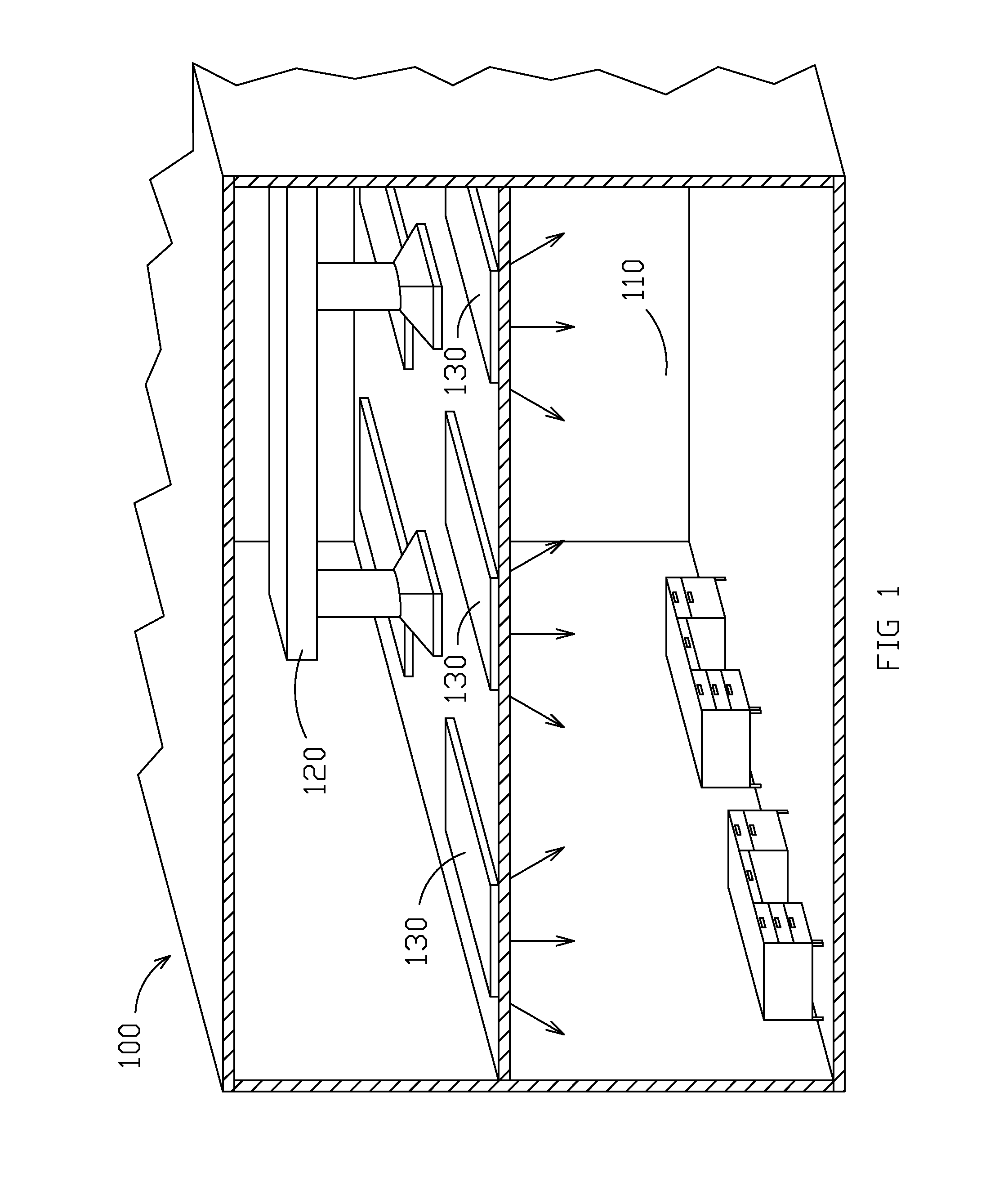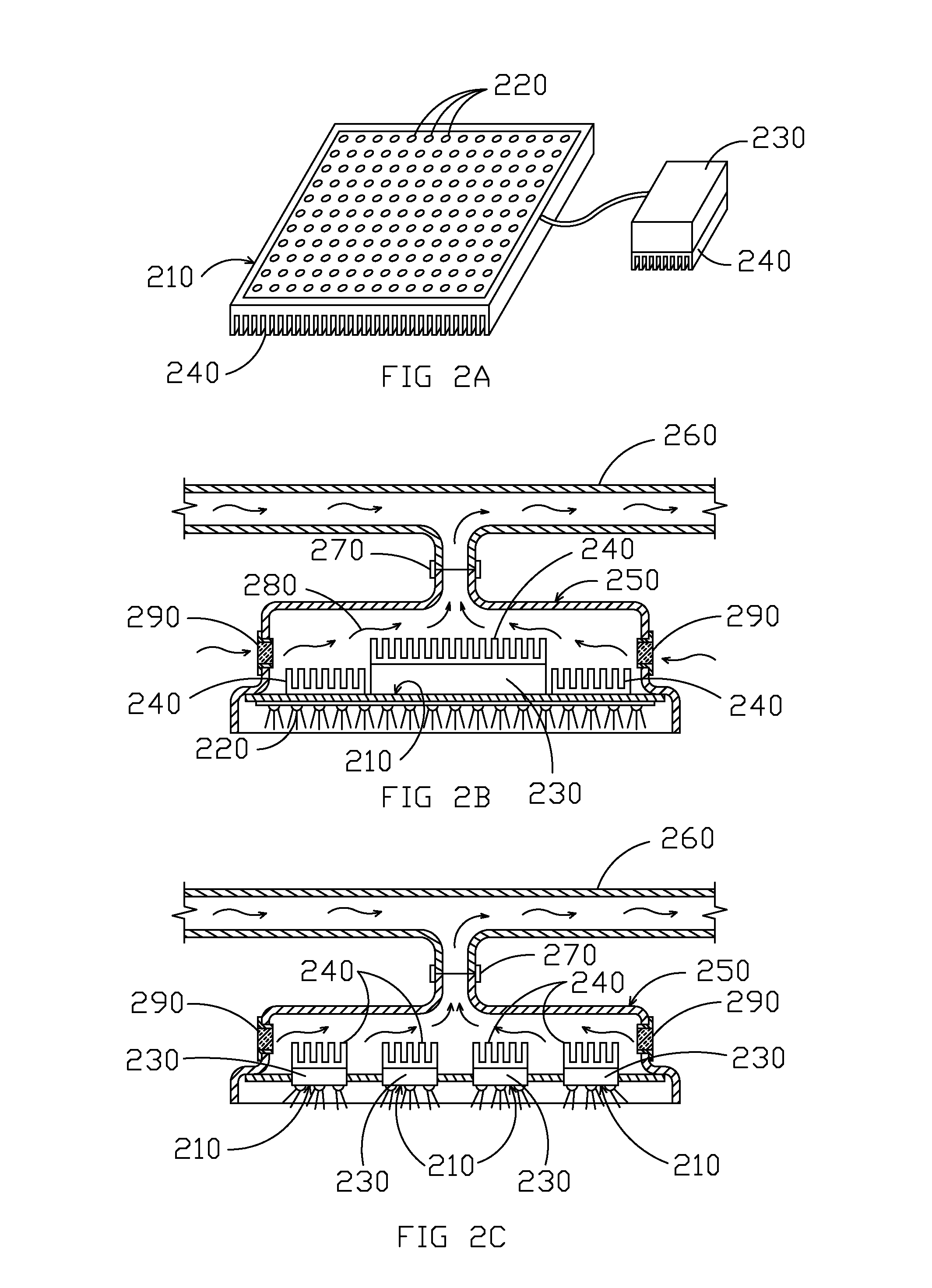Solid state light fixture with cooling system with heat rejection management
a technology of heat rejection management and light fixture, which is applied in the field of solid-state light fixture with heat rejection management, can solve the problems of increasing the total cost of cooling the building, difficulty in adequate heat rejection, and waste of energy from lighting systems and other components, so as to reduce the operating temperature of the light source and/or power circuit, reduce the contribution of heat load from the fixture, and reduce the contribution of heat load
- Summary
- Abstract
- Description
- Claims
- Application Information
AI Technical Summary
Benefits of technology
Problems solved by technology
Method used
Image
Examples
embodiments
Overview
[0077]FIG. 1 illustrates an example of an operating environment 100 in which some embodiments of the present invention may be utilized. Environment 100 shows a space or room 110 that is interior to a building that is temperature controlled. As shown in FIG. 1, the building has a heating ventilation and air conditioning (HVAC) unit and HVAC ductwork 120 installed throughout the building structure. (Alternatively, environment 100 could use a high velocity mini-duct system such as provided by Unico, Inc. (7401 Alabama Ave., St. Louis, Mo. 63111-9906 www.unicosystem.com) instead of conventional HVAC ductwork.) Lighting fixtures 130 provide light to room 110. In addition to light, most light fixtures produce some heat from the light source or the electrical system that provides power to the light fixture.
specific embodiments
Primary Embodiment
[0078]FIGS. 2A-2C illustrate various views of an example of a solid-state light source with power electronics, an enclosure, and a fluid conduit that may be used in accordance with some embodiments of the present invention. FIG. 2A is a perspective view of LED fixture 210 with an array of LED lights 220 that are powered by power electronics 230. Both LED lights 220 and power electronics 230 can use heat sinks 240 to dissipate heat. Power electronics 230 may be mounted directly on, in close proximity to, or remotely from fixture 210. LED lights 220 can be any type of LED or solid-state light.
[0079]Some embodiments of the present invention use solid-state lighting sources for interior applications. Since solid-state lighting sources generally have a “light side” which can be visible in the living space and which does not ordinarily need to be cooled, and since the “heat side” and the driving electronics do not need to be visible, heat is generally dissipated away fro...
first additional embodiment
[0085]FIGS. 3A-3B illustrate examples of reflective lighting enclosures that may be used in some embodiments of the present invention. FIG. 3A is a cross-sectional view of a first side of lighting enclosure 310 while FIG. 3B is a cross-sectional view of a second side of lighting enclosure 310. As shown in FIGS. 3A-3B, lighting enclosure 310 includes an array of LEDs 320 pointed toward a reflective surface 330 on the inside of lighting enclosure 310. The light 370 (FIG. 3B) emitted from LEDs 320 is reflected from reflective surface 330 toward the target area through transparent plates or covers 380. Examples of reflective materials that can be used in some embodiments of the present invention include, but are not limited to, various surfaces of metal and / or plastic that can be embossed, patterned, and / or otherwise configured for light spread or diffusion. In some embodiments, surfaces of the reflective material can be matte, burnished, semi-specular, specular, etc. Other examples inc...
PUM
 Login to View More
Login to View More Abstract
Description
Claims
Application Information
 Login to View More
Login to View More - R&D
- Intellectual Property
- Life Sciences
- Materials
- Tech Scout
- Unparalleled Data Quality
- Higher Quality Content
- 60% Fewer Hallucinations
Browse by: Latest US Patents, China's latest patents, Technical Efficacy Thesaurus, Application Domain, Technology Topic, Popular Technical Reports.
© 2025 PatSnap. All rights reserved.Legal|Privacy policy|Modern Slavery Act Transparency Statement|Sitemap|About US| Contact US: help@patsnap.com



